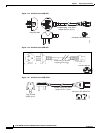
1-23
Cisco ASR 9001 and Cisco ASR 9001-S Routers Hardware Installation Guide
OL-26701-02
Chapter 1 Preparing for Installation
Cisco ASR 9001 Router Port Connection Guidelines
Console Port and Auxiliary Port Connection Guidelines
The RP has two EIA/TIA-232 (formerly RS232) serial RJ-45 connection ports (see Figure 1-23):
• Console port—RJ-45 interface for connecting a data terminal device to the router, which you need
to perform the initial configuration of the router.
• Auxiliary port—RJ-45 interface for connecting a modem.
Note The console and auxiliary ports are asynchronous serial ports. Ensure that devices connected to
these ports are capable of asynchronous transmission.
Console Port Signals
The RP console port is an RJ-45 interface for connecting a terminal to the router. The console port does
not support modem control or hardware flow control and requires a straight-through RJ-45 cable.
Before connecting a terminal to the console port, check the terminal setting for the data transmission
rate, in bits per second (bps). The terminal transmission rate setting must match the default rate of the
RP console port, which is 115200 bps. Set the terminal to these operational values: 115200 bps, 8 data
bits, no parity, 1 stop bits (115200 8N1).
Table 1-3 lists the signals used on the RP console port.
CLUSTER Ports (0/1) SFP For Cascading two Cisco ASR 9001 Router systems.
The pinout and signal level is as per the SFP standard.
This supports copper/optical SFP modules.
Fixed SFP+ Ports (0/1/2/3) SFP+ Fixed ports include 4X10G SFP+ ports and supports
20X1G, 4X10G and 2X10G ports through Ethernet
Plugs.
Table 1-2 Cisco ASR 9001 Router Front Panel Ports Description
Port Name Connector Type Description
Table 1-3 RP Console Port Signals
Console Port Pin Signal Input/Output Description
1 RTS Output Request to Send
2 — — (Not connected)
3 TxD Output Transmit data
4 GND — Signal ground
5 GND — Signal ground
6 RxD Input Receive data
7 — — (Not connected)
8 CTS Input Clear to Send


















